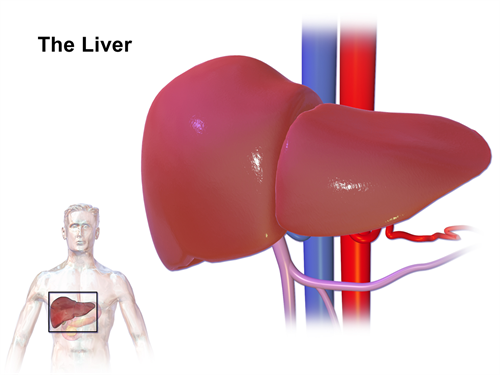Wilson Disease
What is Wilson disease?
Wilson disease is a genetic disease that prevents the body from removing extra copper. The body needs a small amount of copper from food to stay healthy; however, too much copper is poisonous. Normally, the liver filters extra copper and releases it into bile. Bile is a fluid made by the liver that carries toxins and wastes out of the body through the gastrointestinal tract. In Wilson disease, the liver does not filter copper correctly and copper builds up in the liver, brain, eyes, and other organs. Over time, high copper levels can cause life-threatening organ damage.
[Top]
What is the liver?
The liver is the body’s largest internal organ. The liver is called the body’s metabolic factory because of the important role it plays in metabolism—the way cells change food into energy after food is digested and absorbed into the blood. The liver has many important functions, including
- taking up, storing, and processing nutrients from food—including fat, sugar, and protein—and delivering them to the rest of the body when needed.
- making new proteins, such as clotting factors and immune factors.
- producing bile. In addition to carrying toxins and waste products out of the body, bile helps the body digest fats and the fat-soluble vitamins A, D, E, and K.
- removing waste products the kidneys cannot remove, such as fats, cholesterol, toxins, and medications.

A healthy liver is necessary for survival. The liver can regenerate most of its own cells when they become damaged. However, if injury to the liver is too severe or long lasting, regeneration is incomplete and the liver creates scar tissue.
[Top]
What causes Wilson disease?
Wilson disease is caused by an inherited autosomal recessive mutation, or change, in the ATP7B gene. In an autosomal recessive disease, the child has to inherit the gene mutation from both parents to have an increased likelihood for the disease. The chance of a child inheriting autosomal recessive mutations from both parents with a gene mutation is 25 percent, or one in four. If only one parent carries the mutated gene, the child will not get the disease, although the child may inherit one copy of the gene mutation. The child is called a “carrier” of the disease and can pass the gene mutation to the next generation. Genetic testing is a procedure that identifies changes in a patient’s genes and can show whether a parent or child is a carrier of a mutated gene. Autosomal recessive diseases are typically not seen in every generation of an affected family.
The following chart shows the chance of inheriting an autosomal recessive mutation from parents who both carry the mutated gene.

[Top]
Genetic Diseases
Each cell contains thousands of genes that provide the instructions for making proteins for growth and repair of the body. If a gene has a mutation, the protein made by that gene may not function properly. Not all gene mutations cause a disease.
People have two copies of most genes; they inherit one copy from each parent. A genetic disease occurs when one or both parents pass a mutated gene to a child at conception. A genetic disease can also occur through a spontaneous gene mutation, meaning neither parent carries a copy of the mutated gene. Once a spontaneous gene mutation has occurred in a person, that person can pass the gene mutation on to a child.
Read more about genes and genetic conditions in the U.S. National Library of Medicine’s Genetics Home Reference at www.ghr.nlm.nih.govExternal NIH Link.
[Top]
Who is more likely to develop Wilson disease?
Men and women develop Wilson disease at equal rates. About one in 30,000 people have Wilson disease. Symptoms usually appear between ages 5 and 35; however, new cases have been reported in people ages 3 to 72.1
A person’s risk of being a carrier or having Wilson disease increases when his or her family has a known history of Wilson disease. Some people may not know about a family history of the condition because the mutation is often passed to a child by a parent who is a carrier. A person’s chances of having Wilson disease increase if a health care provider has diagnosed one or both parents with the condition.
1
[Top]
What are the signs and symptoms of Wilson disease?
The signs and symptoms of Wilson disease vary, depending on what organs of the body are affected. Wilson disease is present at birth; however, the signs and symptoms of the disease do not appear until the copper builds up in the liver, the brain, or other organs.
When people have signs and symptoms, they usually affect the liver, the central nervous system, or both. The central nervous system includes the brain, the spinal cord, and nerves throughout the body. Sometimes a person does not have symptoms and a health care provider discovers the disease during a routine physical exam or blood test, or during an illness. Children can have Wilson disease for several years before any signs and symptoms occur. People with Wilson disease may have
- liver-related signs and symptoms
- central nervous system-related signs and symptoms
- mental health-related signs and symptoms
- other signs and symptoms
Liver-related Signs and Symptoms
People with Wilson disease may develop signs and symptoms of chronic, or long lasting, liver disease:
- weakness
- fatigue, or feeling tired
- loss of appetite
- nausea
- vomiting
- weight loss
- pain and bloating from fluid accumulating in the abdomen
- edema—swelling, usually in the legs, feet, or ankles and less often in the hands or face
- itching
- spiderlike blood vessels, called spider angiomas, near the surface of the skin
- muscle cramps
- jaundice, a condition that causes the skin and whites of the eyes to turn yellow
Some people with Wilson disease may not develop signs or symptoms of liver disease until they develop acute liver failure—a condition that develops suddenly.
Central Nervous System-related Signs and Symptoms
Central nervous system-related symptoms usually appear in people after the liver has retained a lot of copper; however, signs and symptoms of liver disease may not be present. Central nervous system-related symptoms occur most often in adults and sometimes occur in children.1 Signs and symptoms include
- tremors or uncontrolled movements
- muscle stiffness
- problems with speech, swallowing, or physical coordination
A health care provider may refer people with these symptoms to a neurologist—a doctor who specializes in nervous system diseases.
Mental Health-related Signs and Symptoms
Some people will have mental health-related signs and symptoms when copper builds up in the central nervous system. Signs and symptoms may include
- personality changes
- depression
- feeling anxious, or nervous, about most things
- psychosis—when a person loses contact with reality
Other Signs and Symptoms
Other signs and symptoms of Wilson disease may include
- anemia, a condition in which red blood cells are fewer or smaller than normal, which prevents the body’s cells from getting enough oxygen
- arthritis, a condition in which a person has pain and swelling in one or more joints
- high levels of amino acids, protein, uric acid, and carbohydrates in urine
- low platelet or white blood cell count
- osteoporosis, a condition in which the bones become less dense and more likely to fracture
[Top]
Kayser-Fleischer Rings
Kayser-Fleischer rings result from a buildup of copper in the eyes and are the most unique sign of Wilson disease. During an eye exam, a health care provider will see a rusty-brown ring around the edge of the iris and in the rim of the cornea. The iris is the colored part of the eye surrounding the pupil. The cornea is the transparent outer membrane or layer that covers the eye.
People with Wilson disease who show signs of nervous system damage usually have Kayser-Fleischer rings. However, the rings are present in only 40 to 66 percent of people with signs of liver damage alone.1

[Top]
What are the complications of Wilson disease?
People who have Wilson disease that is not treated or diagnosed early can have serious complications, such as
- cirrhosis—scarring of the liver
- kidney damage—as liver function decreases, the kidneys may be damaged
- persistent nervous system problems when nervous system symptoms do not resolve
- liver cancer—hepatocellular carcinoma is a type of liver cancer that can occur in people with cirrhosis
- liver failure—a condition in which the liver stops working properly
- death, if left untreated
[Top]
How is Wilson disease diagnosed?
A health care provider may use several tests and exams to diagnose Wilson disease, including the following:
- medical and family history
- physical exam
- blood tests
- urine tests
- liver biopsy
- imaging tests
Health care providers typically see the same symptoms of Wilson disease in other conditions, and the symptoms of Wilson disease do not occur together often, making the disease difficult to diagnose.
Medical and Family History
A health care provider may take a medical and family history to help diagnose Wilson disease.
Physical Exam
A physical exam may help diagnose Wilson disease. During a physical exam, a health care provider usually
- examines a patient’s body
- uses a stethoscope to listen to sounds related to the abdomen
A health care provider will use a special light called a slit lamp to look for Kayser-Fleischer rings in the eyes.
Blood Tests
A nurse or technician will draw blood samples at a health care provider’s office or a commercial facility and send the samples to a lab for analysis. A health care provider may
- perform liver enzyme or function tests—blood tests that may indicate liver abnormalities.
- check copper levels in the blood. Since the copper is deposited into the organs and is not circulating in the blood, most people with Wilson disease have a lower-than-normal level of copper in the blood. In cases of acute liver failure caused by Wilson disease, the level of blood copper is often higher than normal.
- check the level of ceruloplasmin—a protein that carries copper in the bloodstream. Most people with Wilson disease have a lower-than-normal ceruloplasmin level.
- conduct genetic testing. A health care provider may recommend genetic testing in cases of a known family history of Wilson disease.
Urine Tests
24-hour urine collection. A patient will collect urine at home in a special container provided by a health care provider’s office or a commercial facility. A health care provider sends the sample to a lab for analysis. A 24-hour urine collection will show increased copper in the urine in most patients who have symptoms due to Wilson disease.
Liver Biopsy
A liver biopsy is a procedure that involves taking a small piece of liver tissue for examination with a microscope for signs of damage or disease. The health care provider may ask the patient to stop taking certain medications temporarily before the liver biopsy. He or she may also ask the patient to fast—eat or drink nothing—for 8 hours before the procedure.
During the procedure, the patient lies on a table, right hand resting above the head. The health care provider applies a local anesthetic to the area where he or she will insert the biopsy needle. If needed, a health care provider will also give sedatives and pain medication. The health care provider uses the needle to take a small piece of liver tissue. He or she may use ultrasound, computerized tomography scans, or other imaging techniques to guide the needle. After the biopsy, the patient must lie on the right side for up to 2 hours and is monitored an additional 2 to 4 hours before being sent home.
A pathologist—a doctor who specializes in diagnosing diseases—examines the liver tissue in a lab. The test can show cirrhosis of the liver. Sometimes the liver biopsy will show copper buildup in the liver cells; however, the results can vary because the copper does not always deposit evenly into the liver. Therefore, health care providers often find it more useful to analyze a piece of liver tissue for copper content. Most patients with Wilson disease have high levels of copper in the liver tissue when compared with carriers or with people who do not have Wilson disease.
More information is provided in the NIDDK health topic, Liver Biopsy.
Imaging Tests
A health care provider may order imaging tests to evaluate brain abnormalities in patients who have nervous system symptoms often seen with Wilson disease, or in patients diagnosed with Wilson disease. Health care providers do not use brain imaging tests to diagnose Wilson disease, though certain findings may suggest the patient has the disease.
Magnetic resonance imaging (MRI). An MRI is a test that takes pictures of the body’s internal organs and soft tissues without using x rays. A specially trained technician performs the procedure in an outpatient center or a hospital, and a radiologist—a doctor who specializes in medical imaging—interprets the images. The patient does not need anesthesia, though people with a fear of confined spaces may receive light sedation, taken by mouth. An MRI may include the injection of a special dye, called contrast medium. With most MRI machines, the patient will lie on a table that slides into a tunnel-shaped device that may be open ended or closed at one end. Some machines allow the patient to lie in a more open space. The technician will take a sequence of images from different angles to create a detailed picture of the brain. During sequencing, the patient will hear loud mechanical knocking and humming noises. MRI can show if other diseases or conditions are causing the patient’s neurological symptoms.
Computerized tomography (CT) scan. A CT scan uses a combination of x rays and computer technology to create images. For a CT scan, a health care provider may give the patient a solution to drink and an injection of contrast medium. CT scans require the patient to lie on a table that slides into a tunnel-shaped device where a technician takes the x rays. An x-ray technician performs the procedure in an outpatient center or a hospital. A radiologist interprets the images. The patient does not need anesthesia. A CT scan can show if other diseases or conditions are causing the patient’s neurological symptoms.
[Top]
How is Wilson disease treated?
A health care provider will treat Wilson disease with a lifelong effort to reduce and control the amount of copper in the body. Treatment may include
- medications
- changes in eating, diet, and nutrition
- a liver transplant
Medications
A health care provider will prescribe medications to treat Wilson disease. The medications have different actions that health care providers use during different phases of the treatment.
Chelating agents. Chelating agents are medications that remove extra copper from the body by releasing it from organs into the bloodstream. Once the cooper is in the bloodstream, the kidneys then filter the copper and pass it into the urine. A health care provider usually recommends chelating agents at the beginning of treatment. A potential side effect of chelating agents is that nervous system symptoms may become worse during treatment. The two medications available for this type of treatment include
- trientine (Syprine)—the risk for side effects and worsening nervous system symptoms appears to be lower with trientine than d-penicillamine. Researchers are still studying the side effects; however, some health care providers prefer to prescribe trientine as the first treatment of choice because it appears to be safer.
- d-penicillamine—people taking d-penicillamine may have other reactions or side effects, such as
- fever
- a rash
- kidney problems
- bone marrow problems
A health care provider will prescribe a lower dose of a chelating agent to women who are pregnant to reduce the risk of birth defects. A health care provider should consider future screening on any newborn whose parent has Wilson disease.
Zinc. A health care provider will prescribe zinc for patients who do not have symptoms, or after a person has completed successful treatment using a chelating agent and symptoms begin to improve. Zinc, taken by mouth as zinc salts such as zinc acetate (Galzin), blocks the digestive tract’s absorption of copper from food. Although most people taking zinc usually do not experience side effects, some people may experience stomach upset. A health care provider may prescribe zinc for children with Wilson disease who show no symptoms. Women may take the full dosage of zinc safely during pregnancy.
Maintenance, or long term, treatment begins when symptoms improve and tests show that copper is at a safe level. Maintenance treatment typically includes taking zinc or a lower dose of a chelating agent. A health care provider closely monitors the person and reviews regular blood and urine tests to ensure maintenance treatment controls the copper level in the body.
Treatment for people with Wilson disease who have no symptoms may include a chelating agent or zinc in order to prevent symptoms from developing and stop or slow disease progression.
People with Wilson disease will take medications for the rest of their lives. Follow-up and adherence to the health care provider’s treatment plan is necessary to manage symptoms and prevent organ damage.
[Top]
Changes in Eating, Diet, and Nutrition
People with Wilson disease should reduce their dietary copper intake by avoiding foods that are high in copper, such as
- shellfish
- liver
- mushrooms
- nuts
- chocolate
People should not eat these foods during the initial treatment and talk with the health care provider to discuss if they are safe to eat in moderation during maintenance treatment.
People with Wilson disease whose tap water runs through copper pipes or comes from a well should check the copper levels in the tap water. Water that sits in copper pipes may pick up copper residue, but running water lowers the level to within acceptable limits. People with Wilson disease should not use copper containers or cookware to store or prepare food or drinks.
To help ensure coordinated and safe care, people should discuss their use of complementary and alternative medical practices, including their use of vitamins and dietary supplements, with their health care provider. Read more at www.nccam. nih.gov/health. If the health care provider recommends taking any type of supplement or vitamin, a pharmacist can recommend types that do not contain copper.
People should talk with a health care provider about diet changes to reduce copper intake.
Liver Transplant
A liver transplant may be necessary in people when
- cirrhosis leads to liver failure
- acute liver failure happens suddenly
- treatment is not effective
A liver transplant is an operation to remove a diseased or an injured liver and replace it with a healthy one from another person, called a donor. A successful transplant is a life-saving treatment for people with liver failure.
Most liver transplants are successful. About 85 percent of transplanted livers are functioning after 1 year.2 Liver transplant surgery provides a cure for Wilson disease in most cases. More information is provided in the NIDDK health topic, Liver Transplantation.
2
[Top]
How can Wilson disease be prevented?
A person cannot prevent Wilson disease; however, people with a family history of Wilson disease, especially those with an affected sibling or parent, should talk with a health care provider about testing. A health care provider may be able to diagnose Wilson disease before symptoms appear. Early diagnosis and treatment of Wilson disease can reduce or even prevent organ damage.
People with a family history of the disease may also benefit from genetic testing that can identify one or more gene mutations. A health care provider may refer a person with a family history of Wilson disease to a geneticist—a doctor who specializes in genetic diseases.
[Top]
Points to Remember
- Wilson disease is a genetic disease that prevents the body from removing extra copper.
- Normally, the liver filters extra copper and releases it into bile. In Wilson disease, the liver does not filter copper correctly and copper builds up in the liver, brain, eyes, and other organs.
- Wilson disease is caused by an inherited autosomal recessive mutation, or change, in the ATP7B gene. In an autosomal recessive disease, the child has to inherit the gene mutation from both parents to have an increased likelihood for the disease.
- The signs and symptoms of Wilson disease vary, depending on what organs of the body are affected. People with Wilson disease may have
- liver-related signs and symptoms
- central nervous system-related signs and symptoms
- mental health-related signs and symptoms
- other signs and symptoms
- A health care provider will treat Wilson disease with a lifelong effort to reduce and control the amount of copper in the body. Treatment may include
- medications
- changes in eating, diet, and nutrition
- a liver transplant
- People with Wilson disease should reduce their dietary copper intake by avoiding foods that are high in copper, such as
- shellfish
- liver
- mushrooms
- nuts
- chocolate
- A person cannot prevent Wilson disease; however, people with a family history of Wilson disease, especially those with an affected sibling or parent, should talk with a health care provider about testing.
[Top]
Clinical Trials
The National Institute of Diabetes and Digestive and Kidney Diseases (NIDDK) and other components of the National Institutes of Health (NIH) conduct and support research into many diseases and conditions.
What are clinical trials, and are they right for you?
Clinical trials are part of clinical research and at the heart of all medical advances. Clinical trials look at new ways to prevent, detect, or treat disease. Researchers also use clinical trials to look at other aspects of care, such as improving the quality of life for people with chronic illnesses. Find out if clinical trials are right for youExternal NIH Link.
What clinical trials are open?
Clinical trials that are currently open and are recruiting can be viewed at www.ClinicalTrials.govExternal Link Disclaimer.
This information may contain content about medications and, when taken as prescribed, the conditions they treat. When prepared, this content included the most current information available. For updates or for questions about any medications, contact the U.S. Food and Drug Administration toll-free at 1-888-INFO-FDA (1-888-463-6332) or visit www.fda.govExternal Link Disclaimer. Consult your health care provider for more information.
The U.S. Government does not endorse or favor any specific commercial product or company. Trade, proprietary, or company names appearing in this document are used only because they are considered necessary in the context of the information provided. If a product is not mentioned, the omission does not mean or imply that the product is unsatisfactory.
[Top]
This content is provided as a service of the National Institute of Diabetes and Digestive and Kidney Diseases (NIDDK), part of the National Institutes of Health. The NIDDK translates and disseminates research findings through its clearinghouses and education programs to increase knowledge and understanding about health and disease among patients, health professionals, and the public. Content produced by the NIDDK is carefully reviewed by NIDDK scientists and other experts.
The NIDDK would like to thank:
Michael L. Schilsky, M.D., Yale-New Haven Hospital Transplantation Center
This information is not copyrighted. The NIDDK encourages people to share this content freely.
[Top]
July 2014

















